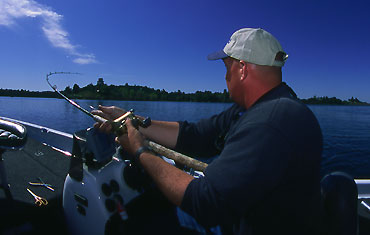The Art of The "TMB" (Top, Middle, Bottom), Don't Be Fooled, The TMB Started here @TheBBZ!
In our previous Big Bass Zone discussions, we hope you've recognized that the top-middle-bottom concept is crucial. The goal is to identify these three key levels and then attack them. However, we may have ignored one item of extreme importance.
In short, the top-middle-bottom concept is not one of elimination, but of refinement. It's not a static concept, but one that constantly changes. Not only do the depth ranges of each level change, but so does the top-middle-bottom of each layer. All of these depth ranges move like a sliding scale as conditions shift.
If you think this sounds too complicated, stop right there. The emphasis of this discussion is to understand the importance of depth refinement. To know where you're fishing a lure, and where a bass strikes that lure, means everything.
If you want to listen to the ballgame, rag on your buddy, no problem – as long as you can focus. Big bass are caught less often for a number of reasons, and one is clearly that presentations are not made at the appropriate depths.
Just about every bass angler has battled with small fish that won't lay off topwater plugs, or exhibit an uncanny knack at getting to plastic worms fished along the bottom. This should tell you something. In particular, it should alert you to the fact that the three major layers – top, middle, bottom – are in constant flux. The top level may be a narrow sliver of depth while the middle section is huge.
The three major layers – top, middle, bottom – are in constant flux, but don't confuse yourself by thinking too much.
These relative depth ranges change with the conditions on a daily basis and, in more extreme situations, on an hourly basis. What happens before 10:00 may be wildly different from the bite after lunch.
If you think this sounds a lot like the Buck Perry formula – depth + speed – give yourself 10 bonus points. The problem is that modern bass fishermen seem intent to complicate the very simple equation. Depth is always a critical factor in any presentation. Don't confuse the issue by thinking too much.
Your goal is to find the "area of contact" – i.e., the precise depth at which bigger bass are willing to strike a lure. If you've changed the cadence of the retrieve, and if the angles of the presentations have been carefully thought out, depth should be next on the list.
Too often, anglers assume that the bass they caught earlier have somehow become "lethargic" or "unwilling to commit to a lure." Not necessarily so. Yes, they may have become less willing to strike, but are these the bass you should be trying to catch?
The area of contact has changed. Whether the fish have "turned off" or simply moved to a different depth range is immaterial. What matters is where you're trying to place your lure.
Whatever happened a moment before is nothing but history. If history repeats itself, then stay with it. These are the moments when the bite is on. Unfortunately, we like to live in the moment long after the moment has passed.
For some reason, bigger bass don't play by the rules. The catch rates reflect it. The window of opportunity is often brief, so when you find the area of contact, don't waste time. Keep your bait in the water – at the right depth.
Simple? Yes, as long as you don't confuse the issue with other thoughts. Water temperature? What happened 2 days ago? They were here this morning, weren't they? Blah, blah, blah.
Buck Perry was oh so right: depth + speed. Even the speed quotient takes a backseat to depth because lure speed (or cadence) is always a learning experience. This is when your intuitive side takes over. This is when you can't be a robot and just crank. You have to be thinking.
But, if you've found the proper depth – the area of contact – where big bass can be enticed, the advantage shifts to the angler. Now the only thing you have to do is get those fish to strike.
Put any tournament professional within shouting distance of bass and he will catch them. Why? Because in some way, he understands the depth + speed formula. The problem, however, comes in evaluating the situation. The tournament angler cannot rely on catching quality, but must pursue numbers. Laying off catchable-size bass is just not an option. But it is an option that any fisherman after larger fish must embrace.
The area of contact has to be one of quality bass, not simply numbers of bass. This is precisely when a complete understanding of the top-middle-bottom concept comes into play. You have to look beyond the general references to depth and understand the subtleties. You have to refine those depth ranges until you find "the depth."
To be content with merely catching fish is not the goal. If it is, then you've found the wrong mentors. Covering the water column isn't an efficient tactic. You must identify those specific sections of the water column where bass are most likely to respond, and then attack them.
Got a limit? Great. Got a big limit? Now you're talking.

